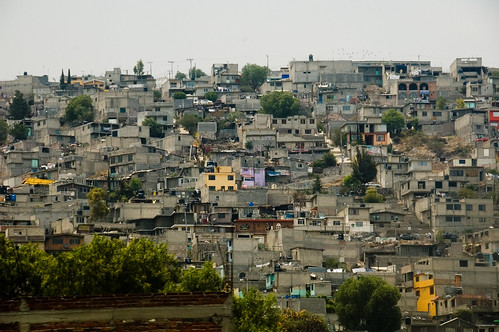
Sometimes better things come in bigger packages. Guatemala City is estimated to have a population around 2 or 3 million people. But it punches below its weight compared to smaller cities culturally, culinarily, architecturally, &c. While it is the firm belief of the Holla that the rest of Guatemala more than makes up for the capital's shortcomings, the city's failings are not uncommon among developing-world metropolies. Millions of rural immigrant laborers moving to the city don't necessarily make up a market for great pad thai. Except maybe in Bangkok.
In any case, on our recent trip to Mexico City, I wasn't sure if we would find a city of 20 million people subsisting on beans. Any fears were misplaced. While Guatemala is a fantastic place to visit if you have some time to get out into the sticks, Mexico City (or "the D.F." as those in the know call it) is a fantastic location for a long weekend visit. It has varied neighborhoods, amazing museums, a rich street life, and an actual middle class and the attendant restaurants, bars and cafés. Since we explored only the center of the city and a few of the nicer outlying neighborhoods, we can't rule out the possibility that there are still 18 million people outside the center subsisting on beans, but there is a Guatemala City-sized core that ranks alongside Buenos Aires at the top of the Latin American city list.
Of course no city of 20 million people is without its attendant difficulties. On wour way into the city from the airport, traffic delays were signifcant. The airport taxis have a central-dispatch system, and when the dispatcher assigned us, and our city-center destination, to the cabbie, he complained loudly that it would take him several days to get there and back. Each time the traffic report came on the radio, he cranked the volume to full blast, possibly to glean any route-finding details possible, but it seemed to be more to make a point that we were idiots to have reserved a hotel downtown. The radio reported that there was a quinceañera parade making its way to the central square, jamming traffic all over. A quinceañera is a girl who is turning 15, which is a huge deal in Latin American cultures - beyond a huge deal. The same way Americans spend ridiculous sums of money on weddings, latinos do the same for 15th birthday parties. We asked the driver who was having a quinceañera parade big enough to shut down most of the city. "Everyone," he replied. We later saw open-top double decker buses packed to bursting with girls in prom dresses being carted into the main square for whatever the event was.
Fortunately, traffic was aviodable because the city has a clean, efficient, and -- as far as our experience went -- safe, Metro. It even provided entertainment, of a sort. On many trains, people hawk their wares on the train cars, always waiting until the second the doors close to start and stopping the second they open again, giving the impression that the law didn't smile on their activities. Nonetheless, we had one ride where over the course of a few stops we had someone trying to sell sharpie markers (two for a dollar!), then someone trying to sell a small radio (this amazing small radio comes with its own earphones!), then someone selling compact discs (with a little backpack sound system blasting), and finally DVDs (actually holding a portable DVD player over her head as she made her way up the train car to demonstrate the quality videos on offer).
Among the tourist-attractions of note, the pyramids at Teotihuacán are magnificent, and very different from the Mayan ruins in Chiapas and Guatemala -- although they do share the crowds and junk peddlers of Mexico's Mayan ruins. The museum of anthropology is an amazing collection in a world-class facility. We overheard one guide lecturing his Hungarian charges about how certain Aztec artifacts were damaged in the "American Invasion." Which of course each side will have a different view of the war, but he went on to emphasize for his Magyar guests: "You are Hungarian. Germany invaded Hungary. The same way, the U.S. invaded Mexico in 1847." Deciding discretion in correcting flagrantly off-base analogies the better part of valor, your correspondent wandered to another of the myriad displays rather than pursue the issue. On the other side of the American-baiting coin were Diego Rivera's masterpiece murals in the public buildings of the city. They were almost uniformly magnificent, although I don't remember from Art History 102 the one with the happy laborers gleefully crushing capitalist skulls with hammers and chopping them up with scythes. Maybe better to stick with Siquieros.




No comments:
Post a Comment